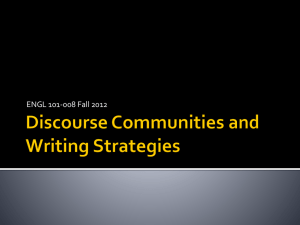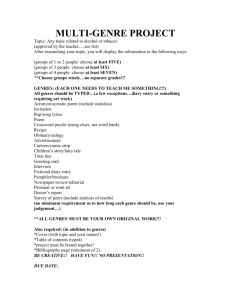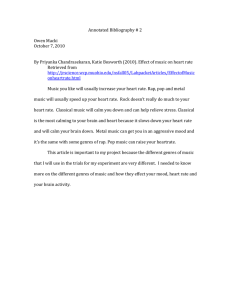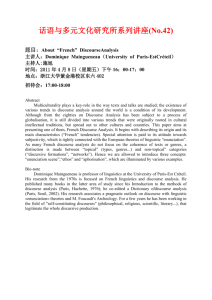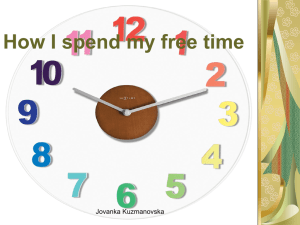Exploring professional discourse
advertisement
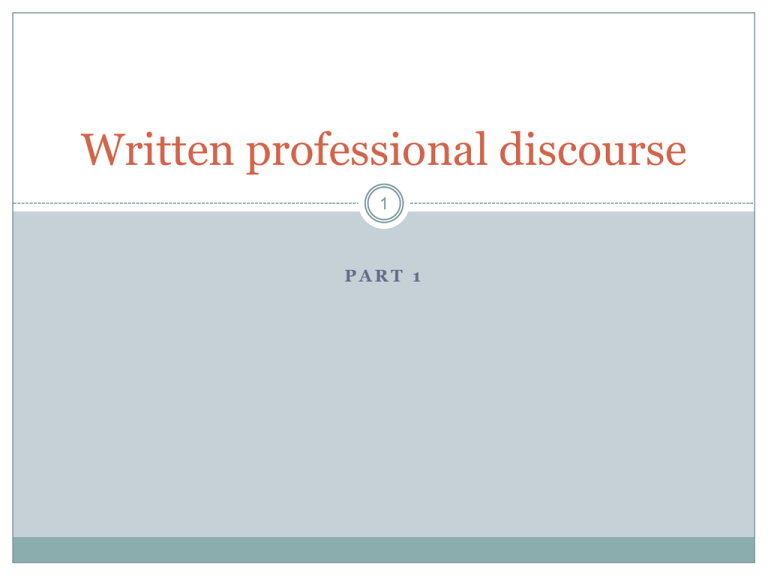
Written professional discourse 1 PART 1 Plan for today’s session 2 Dig deeper into ‘what is professional discourse?’ Provide some examples of written professional genres Start developing tools for identifying genres of professional discourse Professional discourse 3 What is professional discourse? “ text and talk – and the intertwinement of these modalities – in professional contexts and for professional purposes.” (Gunnarsson 2009: 5) Exercise: Is example 1 an instance of professional discourse? Who are participants (how do you know)? What is the context of this exchange (how do you know)? Example 1 4 Subject: Coffee? I am for coffee (and sandwiches!) outside in the sun in about 30 minutes or so – anybody want to join? Anna RE: Coffee? hi my dears, i am at home, marking my assignments 9today and tomorrow) emjoy the sun, as much as i do as i am actually sitting in the garden – have already marked 4! cheers Bella Conceptualising professional discourse 5 Front stage versus back stage encounters Interactions between professionals Interactions between professionals and lay people/clients Clear distinction? Frequent moving between regions Transactional versus relational Getting things done, achieving outcomes Enhancing relationships, creating positive working atmosphere Focus on transactional outcomes but any benefits of relational aspects? Example 2 6 Dear Rebecca, Thanks so much for your prompt reply and for agreeing to review one of the papers! And congratulations on the new baby!! […] Is it a little boy/girl?? A while back, I sent you a Facebook friend request, not sure whether you received it or whether you useFB at all, but if you do, I would love to see some pics of the children... I attended [name of conference], but did not go to [name of city1]. I do hope to get to [name of city2] next year though. I am also organizing a conference in [name of city3], for [topic]. I will be sending info out in the next month or so... I know it is a long way to travel, but it'd be great if you could come... I have attached the paper and the evaluation form. Great to hear that midSeptember works for you.As I mentioned, the special issue focuses on [topic]. Thanks again! All best wishes, Nina Back stage or front stage encounter? Identify transactional and relational aspects Spoken versus written genres 7 What is a genre? “relatively stable forms of communication which develop in the course of production and reproduction of communicative practices, and which are recognized by the members of that community” (Bargiela-Chiappini and Nickerson 1999: 8) No “straightforward correspondence between form and function” (Yeung 2007: 158) Consider: Typical communicative practice Typical participants Typical situations Typical social communities Identifying genres 8 Identify similarities and differences between the documents in example 3 and 4. You may want to consider: the communicative purpose of the texts, the discursive strategies used to achieve these purposes, author and addressee and anything else you consider relevant. Would you say, example 3 and 4 are the same or different genre(s)? Why? Distinguishing spoken and written genres 9 Examples of written genres? Examples of spoken genres? What about email? Internet sites? → multimodality Multimodality 10 Shift from monomodality towards multimodality due to digitization: business letters vs online commercial websites Examples: www.warwick.ac.uk http://www.rsc.org.uk/whats-on/the-taming-of-the-shrew/#trailer Distinction between ‘spoken’ and ‘written’ not always clear-cut Multimodal analyses (e.g. of Warwick website): Consider text (words) But also nonverbal, visual and sound components Interaction of genres 11 Use of multiple (spoken and written) genres to achieve workplace objectives “spoken and written communication were totally intertwined, there was hardly any activity in either mode where the other would not be present as well; many of the email messages referred to phone calls, and they were constantly discussed in face-to-face communication with colleagues” (Louhiala-Salminen 2002: 217) Interaction of genres at work 12 Summary 13 Conceptualising and describing professional discourse: Backstage vs. frontstage Relational vs. transactional Blurry boundary between spoken/written genres Multimodal analysis considering text, visual, nonverbal and acoustic elements etc Some suggestions for further reading 14 Gunnarsson, Britt-Louise (2009). Professional Discourse. London: Continuum. Bargiela-Chiappini, Francesca, Catherine Nickerson & Brigitte Planken (2007). Business Discourse. Basingstoke: Palgrave Macmillan. Yeung, Lorrita (2007). In search of commonalities: Some linguistic and rhetorical features of business reports as a genre. English for Specific Purposes 26: 156-179. Dos Santos, Valeria B.M (2002). Genre analysis of business letters of negotiation. English for Specific Purposes 21: 167-199. Flowerdew, John & Alina Wan (2006). Genre analysis of tax computation letters: How and why tax accountants write the way they do. English for Specific Purposes 25: 133-153. Gimenez, Julio (2002). New media and conflicting realities in multinational corporate communication: A case study. IRAL 40: 323-343.


